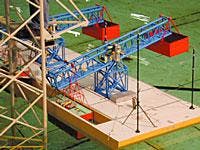Twin Marine Lifter handles nearly 20,000 tons using water and air
Rolf Olavesen,SeaMetric International AS
A new environmentally friendly and cost-effective marine heavy-lift concept could be a viable alternative to the existing heavy lifting methods. SeaMetric Inter-national AS is developing the Twin Marine Lifter, a concept based on a novel way of combining existing proven technologies. The system consists of:
- Two customized barges
- Two six-lift arm systems per barge
- One control and surveillance system
- One heavy transport vessel or barge for transport.
Proven technology
The TML concept is built on simple principles and proven technologies that are combined in a uniquely new arrangement. The concept is based on buoyancy, ballast tanks, and lifting arms located on two custom barges 120 x 46 x 9 m. The lift arms are supported on a skid structure onboard the barges. The arm support structure is 16 m high and has a base of 10 x 16 m. Each lifting arm is hinged to the skid structure at the center of the barge and is equipped with a buoyancy tank between the barge and the object to be lifted. Each 10 x 10 x 15-m tank is made up of nine compartments. There is an 8 x 10 x 12-m ballast tank on the side of the lifting arm opposite the buoyancy tank. One barge with lifting arms is positioned and moored on each side of the object to be lifted.
The idea is to create a single lift by de-ballasting the buoyancy tanks while ballasting the ballasting tanks, without introducing dynamic forces at the interface points. This is done using seawater pumps. Movements are at the barges and lifting arms. The lifted object experiences much smaller movements. The lift arms can be loaded individually to take care of possible differences between the center of gravity and the geometrical center. Positioning is accomplished using anchors. Tugs and anchor-handling vessels are used as support during the actual lift operation.
Normal operation time is 24 hours, which covers the estimated time from arrival on the location until the operation is completed. For a removal operation, the operation is considered completed, for example, when the topside is located on the transportation barge.
The primary safety feature of the lifting operation itself is that it is unmanned. It is controlled from a command vessel. All system components have 100% redundancy.
Proving the concept
The design has already undergone evaluation, testing, and verification, including environmental assessment, a hazard identification study of operation, marine stability and motion analyses, hydrodynamic calculations, model testing, concept design verification, and pre-engineering verification. Marine procedures have been outlined, and functional specifications have also been prepared.
A number of technical studies and third-party evaluations also have been performed to confirm feasibility and to identify technical merits. The results so far have been positive.
Phase 1 model testing was very encouraging. Analysis of barge motions in varying load conditions and in a range of wave conditions was carried out to establish forces, motions, and stability. The Phase II model test is a part of a project funded by the European Union and includes two barges lifting a topside and jacket. A complete installation as well as a removal operation also will be performed.
System benefits
All of the TML's subsystems are known and proven. And because environmental implications and safety issues were focal points in concept development and operational procedures, the operation will be considerably more environmental friendly than other commonly used heavy-lift methods.
As a result, the TML shows benefits that do not exist with other heavy-lift concepts. The concept offers:
- Reduced energy consumption and emissions
- Improved safety
- Reduced cost because the TML system requires less preparation and operation time
- Lower capital expenditure
- Flexibility regarding weight and configuration
- Improvements with regard to sea-state capabilities.
In addition, TML will be more robust in harsh weather and will be more cost effective than traditional heavy lifts. In-house cost analysis showed a cost reduction of 30-40% from traditional methods.
Industry shows interest
TotalFinaElf has awarded SeaMetric a study for removing the QP platform jacket on the Frigg field in the Norwegian sector of the North Sea using the Twin Marine Lifter. The company is focusing on various development programs in addition to this study. SeaMetric is funded by the European Commission for developing the control and surveillance systems. Cooperation agreement with industrial partners is also an important issue, as is the ongoing pre-qualification for Phillips Petroleum Co., for the removal of platforms in the Ekofisk area offshore Norway.
The US Minerals Management Serv-ices, which regulates the petroleum sector, is also keen to determine the feasibility of the concept. SeaMetric has presented a white paper and proposal for a decommissioning study to the MMS.
The TML concept was nominated for the Innovation Award at the Offshore Northern Seas (ONS) 2002 conference and exhibition Aug. 27-30, 2002, in Stavanger.
The TML system has a patent pending status worldwide and is planned to be in operation late 2003 or early 2004.
Author
Rolf Olavesen is a mechanical engineer with 22 years' experience in the offshore industry, initially in engineering consulting, and later as a supervisor of engineering projects. For the last 10 years, he has held management positions in major Engineering, Procurement, Construction, and Installation projects for leading international oil and gas companies. He is responsible for project coordination in SeaMetric International AS.

